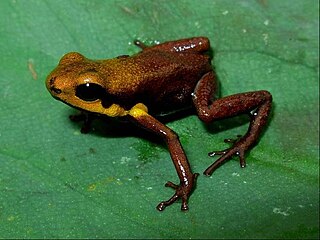
The flannel moths or crinkled flannel moths are a family of insects. They occur in North America and the New World tropics. The larvae are called puss caterpillars, and with their long hairs, resemble cotton balls. They have venomous spines that can cause a painful sting and inflammation lasting for several days. In some cases, the sting may cause headache, nausea, and shock-like symptoms. Perhaps the most notorious for stinging is the caterpillar of Megalopyge opercularis.

The tropical mockingbird is a resident breeding bird from southern Mexico to northern and eastern South America and in the Lesser Antilles and other Caribbean islands.
Salvia tolimensis is a perennial shrub endemic to a very small region in Colombia (Tolima) growing on streamsides, scrublands, and forest edges in wet conditions at 2,400 to 3,500 m elevation. The plant is a vigorous undershrub, about 1 metre (3.3 ft) high, with narrow ovate leaves that are 6 to 10 cm long and 2.5 to 4 cm wide. The purple flowers are 2.2 to 2.5 cm long.

Dismorphia crisia, the crisia mimic white or cloud forest mimic-white, is a butterfly in the family Pieridae. The species was first described by Dru Drury in 1782. It is found from northern Central America to Bolivia and the Amazon basin.
Hysterocladia is a genus of moths in the family Megalopygidae.
Paracles tolimensis is a moth of the subfamily Arctiinae first described by Paul Dognin in 1912. It is found in Colombia.
Ischnocampa tolimensis is a moth of the family Erebidae. It was described by Walter Rothschild in 1916. It is found in Colombia.
Hysterocladia servilis is a moth of the family Megalopygidae. It was described by Walter Hopp in 1927. It is found in Peru.
Hysterocladia werneri is a moth of the family Megalopygidae. It was described by Walter Hopp in 1927. It is found in Colombia.
Hysterocladia ferecostata is a moth of the family Megalopygidae. It was described by Walter Hopp in 1927. It is found in Peru.
Hysterocladia primigenia is a moth of the family Megalopygidae. It was described by Walter Hopp in 1927. It is found in Peru.
Hysterocladia corallocera is a moth of the Megalopygidae family. It was described by Felder in 1874. It is found in Venezuela and French Guiana.
Hysterocladia eriphua is a moth of the Megalopygidae family. It was described by Paul Dognin in 1914. It is found in Panama.
Hysterocladia lena is a moth of the Megalopygidae family. It was described by Schaus in 1912. It is found in Costa Rica.
Hysterocladia roseicollis is a moth of the Megalopygidae family. It was described by Paul Dognin in 1914. It is found in Peru and French Guiana.
Hysterocladia unimana is a moth of the family Megalopygidae. It was described by Walter Hopp in 1943. It is found in Brazil.
Zamia tolimensis is a species of cycad in the family Zamiaceae.

Andinobates tolimensis, the Tolimense poison frog, is a species of amphibian in the family Dendrobatidae, endemic to Colombia in the outskirts of Falan and north of the department of Tolima. Previously it was included in the genus Ranitomeya, but was reclassified in Andinobates, along with 11 other species. It is threatened by habitat loss. It is toxic to humans and when captured will excrete a milky substance.

Maria Cristina Ferro de Carrasquilla was a Colombian microbiologist and Leishmaniasis researcher who worked for more than forty years at the National Health Institute of Colombia. Most of her research was focused on sandflies, which are Leishmaniasis vectors, contributing with the description of three new species: Lutzomyia torvida, Lutzomyia falcata, and Lutzomyia tolimensis. Given her research contributions, a sandfly species was named after her: Lutzomyia ferroae. Ferro also worked with Venezuelan equine encephalitis virus and received the Emeritus Researcher award from the National Health Institute of Colombia in 2007
Anolis tolimensis is a species of lizard in the family Dactyloidae. The species is found in Colombia.




